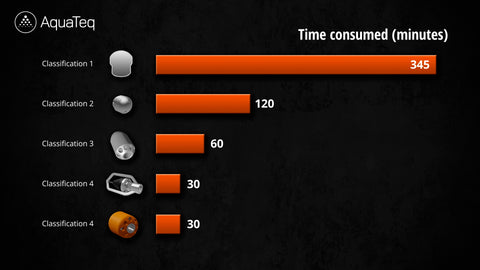
Flushing Efficiency - When 1 + 1 Becomes 3
What does the word efficiency entail when it comes to cleaning pipes, regarding wastewater and stormwater?
Looking at the word efficiency in general, it’s usually explained by:
Efficiency - Taking care of a specific matter in the correct way, means doing it in the most preferable, quickest and cheapest manner possible. In other words, it’s all about finding the most productive way.
A positive aspect of doing things in a productive manner is that most often the burden on the environment will be reduced.
If we dive deep into the significance of the word efficiency when it comes to our industry, we would like to highlight three areas that can be directly improved at each individual pipe cleaning project.

WATER CONSUMPTION - Each cleaning nozzle use a certain number of liters per minute/ Gallons per minute, depending on the jet insert size set-up. The water consumption per minute will be less if the cleaning nozzle is set up for less liter per minute. But there are other essential areas that will affect the efficiency and the Total water consumption.

TIME - The number of passes a nozzle must do in the pipe to clean it requires time. It’s obvious to everyone that the result of having to do fewer passes means saving precious time. A cleaning nozzle that is more efficient but use more liter per minute will at the end save a lot of water totally since it needs fewer passes to clean the pipe.
In addition, each pass requires the creation of water under pressure and to do so, power must be extracted from an engine. Finally, there is a third area that we can influence which is:

DIESEL - To create water under pressure, a certain speed is required on the engine, which in turn, operate the water pump. The engine mostly consumes diesel. An average jetting truck consumes between 25-50 liters of diesel (7-13 GPM) per hour depending on its capacity and construction.,
But how do we reduce our consumption of valuable time, water and diesel?
The cleaning task is performed by the nozzle. The cleaning nozzle is the very key to reducing the consumption in all the three mentioned areas above. But how can we achieve this?
1. One of the most essential factors is to make sure that each nozzle used on the jetting truck is set up and adapted to the truck and its mission.
2. It’s of the outmost importance to use the correct cleaning nozzle for each individual job. All types of nozzles have their specific assigned areas of work, which means that it’s essential to choose the right nozzle for each task. A nozzle used for clogged pipes is not suitable, nor efficient, when it comes to cleaning a pipe from sand, gravel, sludge etc. A descaling nozzle should be used to remove deposits in pipes or, for example, finer roots. It’s not intended for moving large amount of material in pipe.

3. Work with the correct pressure. Different pipe cleaning nozzles each have their optimal working pressures, that is where they operate most efficient. Furthermore, the water flow should at this optimal working pressure, be adapted to the size of the pipe. It requires fewer liters per minute to clean a smaller pipe compared to a larger one. This is also something that should be considered when adapting the cleaning nozzles to the jetting truck.
If you use an efficient cleaning nozzle to remove material in pipe, it can be operating at a much lower pressure than if the assignment is to open clogged pipes, milling or descaling.
At AquaTeq® we possess an extensive knowledge of all our products and how they in the best way possible can be optimized for each jetting truck. We help our customers on a daily basis with streamlining their cleaning projects. This is done by making a thorough analysis of the most common cleaning assignments and in which pipe dimensions they are done. We equip both new and existing jetting units as well as providing advice and information on the best usage of each individual nozzle or cutter.
